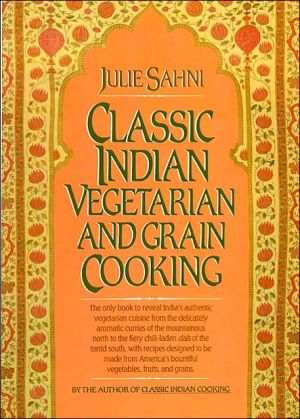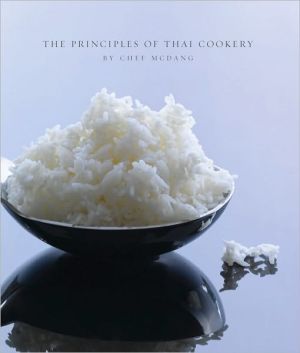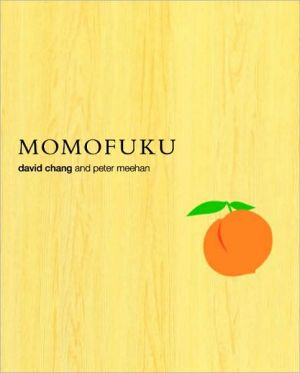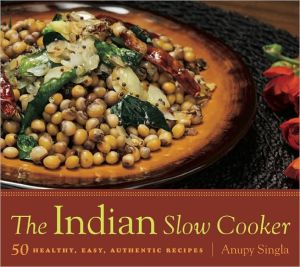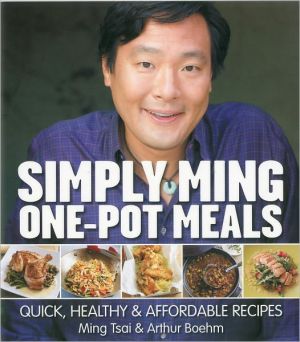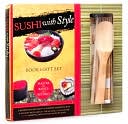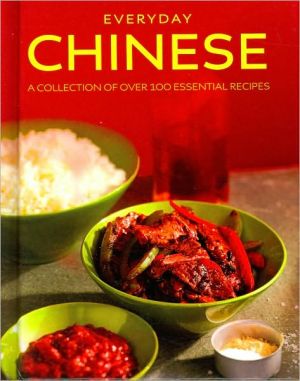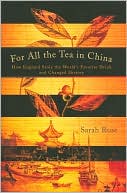Classic Indian Vegetarian and Grain Cooking
Julie Sahni's remarkable ability to make authentic Indian cooking accessible to American cooks continues to make her first book, Classic Indian Cooking, the definitive work of its kind.\ This is her long-awaited second book. To prepare it, Julie Sahni traveled extensively throughout the regions of her native India, to assemble a splendid second volume of Indian culinary delights. Whereas her first book explored the riches of Moghul cuisine, this totally new collection systematically reveals...
Search in google:
Julie Sahni's remarkable ability to make authentic Indian cooking accessible to American cooks continues to make her first book, Classic Indian Cooking, the definitive work of its kind.This is her long-awaited second book. To prepare it, Julie Sahni traveled extensively throughout the regions of her native India, to assemble a splendid second volume of Indian culinary delights. Whereas her first book explored the riches of Moghul cuisine, this totally new collection systematically reveals the never-before-described treasures of India's vegetarian and grain cooking.The book begins with a simple explanation of the ingredients and techniques characteristic of this cuisine. For the first time anywhere, Julie describes every classical blend of curry in the Indian tradition, with accompanying recipes on how to use them. From this book alone you will become master both of India's wonderful curries and of the many new varieties you will now know how to create for yourself.In addition to a thorough going mastery of cooking with curry, this book provides a complete experience of India's incredibly varied vegetarian and grain dishes. Try the heavenly spread of yogurt cheese flavored, with fresh herbs, a favorite of the Gujarati Jains. Be adventurous: make Steamed Rice and Bean Dumplings in Spicy Lentil and Radish Sauce, traditionally served as tiffin one of the great classics of Indian vegetarian cooking.Vegetarians, the super health-conscious, and meat eaters who want to vary their menu with exciting new dishes, all will want to sample the vegetarian masterpiecesvirtual one-dish feasts-that are the very heart of this book: Malabar Coconut and Yogurt-Braised Vegetables; Hearty Blue Mountain Cabbage and Tomato Stew; Baked Zucchini Stuffed with Vegetarian Keema and BuIgur; Madras Fiery Eggplant, Lentil, and Chili Stew; and so many many others. To accompany these dishes, Julie provides an abundance of chutneys, pickles, breads, rice dishes, dals, vegetable side dishes, yogurt salads, and volcanically hot condiments.Any time of the day you can snack or nibble on tasty foods that will contribute to your health but not your waistline: refreshing chats (salads without oil), a succulent array of fritters, kaftas, and kababs all ingeniously created from fresh vegetables, and a wide selection of crunchy savories from plantain chips to the irresistible giant papad (lentil wafer).Your sweet tooth is not neglected by India's vegetarian and grain cooking. Lotus Seed Pudding, kulfi (India's delicious ice cream), coconut dumplings, and Quick Glazed Carrot Halwa are only the beginning of the unbelievable assortment of desserts and sweets Julie Sahni's Classic Indian Vegetarian and Grain Cooking makes available to you. Plus divine recipes for lassi (yogurt drink), refreshing teas, and classic South Indian coffee.This invaluable and instructive book places India's ancient tradition of delicious vegetarian and grain dishes directly into your hands. Publishers Weekly One might expect that this fine sequel to Sahni's Classic Indian Cooking covers a smaller subject than that earlier work. But since most Indians are vegetarians, and since they cook in a diversity of styles, this new volume in many senses gives a truer panorama of that nation's classic cuisine. After an exhaustive glossary of foodstuffs and spices that make up the Indian larder, Sahni launches into the recipes, which in a rare concession to Western ways are arranged course by course. There is much that even a devotee of Indian cooking will find new in the areas of fritters and griddle cakes, braised dishes, lentils, chutneys. Though the ingredients are often exotic, Sahni's directions for buying (a mail-order guide is included) and cooking are precise. She brings some of the subtler practices of one of the world's great cuisines within America's reach. Foreign rights: Esther Newberg, ICM. November 25
MADRAS FIERY EGGPLANT, LENTIL, AND\ CHILI STEW\ (Pitlai)\ Laced with chilies and then more chilies, pitlai (Madras eggplant stew) is one of the hottest preparations in all of southern cuisine. The characteristic taste of pitlai comes from the flavor of a fried spice paste consisting of coconut, chilies, coriander, and various legumes that are infused into the sauce. For a milder taste just decrease the quantity of chilies.\ FOR 4-6 PERSONS\ \ \ For the spice paste:\ \ \ \ 3 tablespoons light sesame or\ light vegetable oil\ 2 tablespoons yellow split peas\ (channa dal)\ 1 tablespoon split white gram\ beans (urad dal)\ 5 tablespoons coriander seeds\ 1 teaspoon turmeric\ 3 cups water\ 2 1/2 - 3 cups cooked yellow or red\ lentils (p. 318)\ 1 teaspoon black peppercorns\ 12 dry red chili pods\ 3 tablespoons dry flaked\ unsweetened coconut (khopra)\ 1/2 cup water, or more\ 2 pounds eggplant, unpeeled, cut\ into 1-inch cubes\ 1 1/2 teaspoons coarse salt, or to\ taste\ \ \ \ \ For the spice-perfumed butter:\ \ \ \ 2 tablespoons usli ghee (p. 75) or\ light vegetable oil\ 2 teaspoons black mustard seeds\ 1/2 teaspoon ground asafetida\ 8-10 curry (kari) leaves, freshor\ dry (optional)\ \ \ \ Heat the oil in a small frying pan over medium-low heat for 3 minutes. Pick clean the split peas and the gram beans and add them to the oil and fry, stirring, for I minute or until they just begin to fry. Add the coriander seeds and peppercorns and continue frying for I more minute. Add the chili pods and fry all the ingredients until the legumes turn light golden and the spices smell fried. Add the coconut, mix the ingredients for 15 seconds, and turn off the heat. Put the spice mixture into the container of an electric blender along with 1/2 cup water. Process until it reduces to a fine sauce. If necessary, add more water. Set aside.\ Put the eggplant, turmeric, and water in a large heavy saucepan and bring to a boil. Cook the eggplant cubes over medium-high heat, covered, for 5 minutes. Add the cooked lentils, mix well, and continue cooking for I more minute.\ Add the ground spice paste and salt to taste. Stir well, but carefully, to distribute the spices evenly into the eggplant. Turn off heat.\ Measure out the spices and place them right next to the stove in separate piles. Heat the ghee or oil in a small frying pan over high heat. When it is very hot, add the mustard seeds. Keep a pot lid handy, as the seeds may fly all over. When the spattering subsides, take the pan off the heat, and add the asafetida and curry leaves. Let the spices and herbs sizzle in the ghee for 10 or 15 seconds, then pour the entire contents of the pan over the eggplant. Gently stir to fold in the spices. Heat thoroughly before serving.\ \ Follow menu suggestions given for Tanjore Broccoli and Mung Bean Stew with Coconut (p. 240).\ \ BAKED EGGPLANT STUFFED WITH CHEESE\ AND HERBS\ (Bhara Paneer Baigan)\ An elegant and beautifully seasoned preparation, these stuffed eggplant halves are very popular with -urban Indians and Anglo-Indians in Kanpur, the Northern Province of India. You can use zucchini, yellow summer squash, or small butternut squash in place of the eggplant, but remember to adjust the cooking time.\ FOR 2 PERSONS\ \ \ One 1-pound eggplant\ 4 tablespoons light vegetable oil\ 3/4 cup chopped onion\ 1 tablespoon grated or crushed\ fresh ginger\ 3/4 teaspoon red pepper\ 1 1/2 teaspoons ground coriander\ 3/4 cup finely chopped tomatoes\ 1/4 cup finely chopped sweet\ green pepper\ Indian cheese (chenna) made\ with 4 cups whole milk\ (p. .70), or 8 ounces farmer's\ cheese or pot cheese\ 1 tablespoon lemon juice\ 1 teaspoon coarse salt, or to taste\ Chopped coriander for garnish\ \ \ \ Preheat the oven to 375° F.\ Cut the eggplant in half Carefully scoop out the pulp and chop fine. Reserve the shells.\ Heat a large frying pan over high heat until very hot. Add 2 tablespoons of oil along with the onion and cook for 3 minutes. Add the ginger and continue cooking for 2 more minutes. Add the pepper and the coriander, shake the pan for a few seconds, and add the chopped eggplant. Reduce the heat to medium and cook the eggplant, stirring, until cooked and pulpy (about 10 minutes).\ Add the tomatoes, green peppers, and cheese, and stir gently just to mix. Let the mixture cook for I minute. Turn off the heat. Stir in the lemon juice and salt.\ Place the eggplant shells in a baking dish. Spoon the filling into the shells. Dribble the remaining oil over them. Cover with foil and bake in the middle of the oven for 30 minutes. Uncover and continue baking for 15 more minutes.\ \ Serve sprinkled with chopped coriander and, if desired, spoon on a little Sweet and Spicy Tamarind Chutney (p. 368) or Coriander Chutney (p. 366). These stuffed eggplants are perfect luncheon or light supper entrees accompanied by any bread from the Staples section or plain boiled rice. North Indian Vegetable Salad (p. 334) would also be a-good accompaniment.\ \|\|Classic Indian Vegetarian & Grain Ck. Copyright © by Julie Sahni. Reprinted by permission of HarperCollins Publishers, Inc. All rights reserved. Available now wherever books are sold.\|
\ From Barnes & NobleJulie Sahni is one of the most innovative and imaginative cooks writing today, and her recipes are a joy to re-create. Always authentic, full of recipes for flavorful dishes, and informative, her cookbooks are an important addition to your culinary shelf. The varieties of Indian vegetarian cuisine that she introduces to the American cook in this book are enticing -- everything from the faintly sweet, aromatic curries of the north to the potent dishes of the subtropical south are yours for the picking.\ \ \ \ \ Publishers Weekly - Publisher's Weekly\ One might expect that this fine sequel to Sahni's Classic Indian Cooking covers a smaller subject than that earlier work. But since most Indians are vegetarians, and since they cook in a diversity of styles, this new volume in many senses gives a truer panorama of that nation's classic cuisine. After an exhaustive glossary of foodstuffs and spices that make up the Indian larder, Sahni launches into the recipes, which in a rare concession to Western ways are arranged course by course. There is much that even a devotee of Indian cooking will find new in the areas of fritters and griddle cakes, braised dishes, lentils, chutneys. Though the ingredients are often exotic, Sahni's directions for buying (a mail-order guide is included) and cooking are precise. She brings some of the subtler practices of one of the world's great cuisines within America's reach. Foreign rights: Esther Newberg, ICM. November 25\ \
